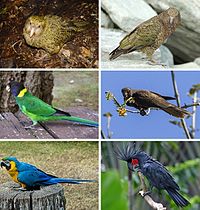
Photo from wikipedia
Climate change is contributing to biodiversity redistributions and species declines. However, cooler microclimate conditions provided by old‐growth forest structures compared with surrounding open or younger forests have been hypothesized to… Click to show full abstract
Climate change is contributing to biodiversity redistributions and species declines. However, cooler microclimate conditions provided by old‐growth forest structures compared with surrounding open or younger forests have been hypothesized to provide thermal refugia for species that are sensitive to climate warming and dampen the negative effects of warming on population trends of animals (i.e., the microclimate buffering hypothesis). In addition to thermal refugia, the compositional and structural diversity of old‐growth forest vegetation itself may provide resources to species that are less available in forests with simpler structure (i.e., the insurance hypothesis). We used 8 years of breeding bird abundance data from a forested watershed, accompanied with sub‐canopy temperature data, and ground‐ and LiDAR‐based vegetation data to test these hypotheses and identify factors influencing bird population changes from 2011 to 2018. After accounting for imperfect detection, we found that for 5 of 20 bird species analyzed, abundance trends tended to be less negative or neutral at sites with cooler microclimates, which supports the microclimate buffering hypothesis. Negative effects of warming on two species were also reduced in locations with greater forest compositional diversity supporting the insurance hypothesis. We provide the first empirical evidence that complex forest structure and vegetation diversity confer microclimatic advantages to some animal populations in the face of climate change. Conservation of old‐growth forests, or their characteristics in managed forests, could help slow the negative effects of climate warming on some breeding bird populations via microclimate buffering and possibly insurance effects.
Journal Title: Global Change Biology
Year Published: 2022
Link to full text (if available)
Share on Social Media: Sign Up to like & get
recommendations!